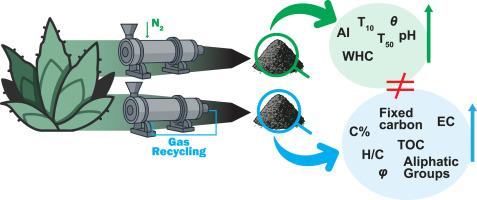从半干旱生物质到碳固存:热解气氛和温度对龙舌兰衍生生物炭特性的影响
IF 5.8
2区 生物学
Q1 AGRICULTURAL ENGINEERING
引用次数: 0
摘要
生物炭已成为一种可扩展的负排放技术,具有良好的农学和环境效益。在这种情况下,干旱和半干旱地区是通过土壤生物炭应用去除碳的有希望的地区,特别是在探索具有高能量潜力的新的非粮食生物质资源时,如龙舌兰。本研究旨在通过比较氮气(N2)和循环热解气体(PyGR)在350、425、500和575℃四种温度下对龙舌兰生物炭性能的影响,探讨热解气氛对龙舌兰生物炭性能的影响。pygr基生物炭具有更高的碳含量(高达71.36%)、能量密度和丰富的表面化学(脂肪族官能团增加,溶解有机碳保留),而n2基生物炭具有更高的芳香性、更高的热稳定性和更低的挥发性化合物含量。在处理和界面性能方面也存在差异,pygr基生物炭具有更好的流动性和疏水性,而n2基生物炭具有更好的保水性。多变量分析表明,热解气氛对原子比(H/C、O/C)、芳香族指标和热降解谱等关键指标有重要影响。因此,在实验规模的研究中使用惰性气体可能会歪曲在现实工业条件下生产的生物炭的碳持久性和农艺行为。此外,龙舌兰具有良好的生物炭特性,是半干旱地区生产生物炭的宝贵生物质。本文章由计算机程序翻译,如有差异,请以英文原文为准。

From semi-arid biomass to carbon sequestration: Role of pyrolysis atmosphere and temperature on agave-derived biochar properties
Biochar has emerged as a scalable negative emission technology with promising agronomic and environmental benefits. In this context, arid and semi-arid regions represent promising zones for carbon removal through soil biochar application, particularly when exploring new non-food biomass sources with high energy potential, such Agave wercklei. This study aims to evaluate the properties of biochars produced from Agave wercklei and investigate the role of pyrolysis atmosphere by comparing nitrogen (N2) and recirculated pyrolysis gas (PyGR) across four temperatures (350, 425, 500, and 575 °C). PyGR-based biochars exhibited higher carbon content (up to 71.36 %), energy density, and enriched surface chemistry with increased aliphatic functional groups, retention of dissolved organic carbon, while N2-based biochars showed greater aromaticity, higher thermal stability, and lower content of volatile compounds. Differences were also observed in handling and interfacial properties, with PyGR-based biochars presenting superior flowability and higher hydrophobicity, while N2-based biochars exhibited greater water retention. Multivariate analysis revealed that the pyrolysis atmosphere plays a crucial rule in key indicators, including atomic ratios (H/C, O/C), aromatic indices, and thermal degradation profiles. Thus, the use of inert gas in bench-scale studies may thus misrepresent the carbon permanence and agronomic behavior of biochars produced under realistic industrial conditions. Furthermore, Agave wercklei demonstrated favorable biochar properties, positioning it as a valuable biomass for producing biochar in semi-arid regions.
求助全文
通过发布文献求助,成功后即可免费获取论文全文。
去求助
来源期刊

Biomass & Bioenergy
工程技术-能源与燃料
CiteScore
11.50
自引率
3.30%
发文量
258
审稿时长
60 days
期刊介绍:
Biomass & Bioenergy is an international journal publishing original research papers and short communications, review articles and case studies on biological resources, chemical and biological processes, and biomass products for new renewable sources of energy and materials.
The scope of the journal extends to the environmental, management and economic aspects of biomass and bioenergy.
Key areas covered by the journal:
• Biomass: sources, energy crop production processes, genetic improvements, composition. Please note that research on these biomass subjects must be linked directly to bioenergy generation.
• Biological Residues: residues/rests from agricultural production, forestry and plantations (palm, sugar etc), processing industries, and municipal sources (MSW). Papers on the use of biomass residues through innovative processes/technological novelty and/or consideration of feedstock/system sustainability (or unsustainability) are welcomed. However waste treatment processes and pollution control or mitigation which are only tangentially related to bioenergy are not in the scope of the journal, as they are more suited to publications in the environmental arena. Papers that describe conventional waste streams (ie well described in existing literature) that do not empirically address ''new'' added value from the process are not suitable for submission to the journal.
• Bioenergy Processes: fermentations, thermochemical conversions, liquid and gaseous fuels, and petrochemical substitutes
• Bioenergy Utilization: direct combustion, gasification, electricity production, chemical processes, and by-product remediation
• Biomass and the Environment: carbon cycle, the net energy efficiency of bioenergy systems, assessment of sustainability, and biodiversity issues.
 求助内容:
求助内容: 应助结果提醒方式:
应助结果提醒方式:


